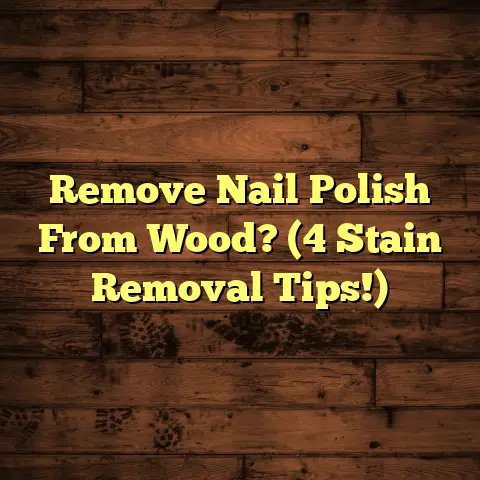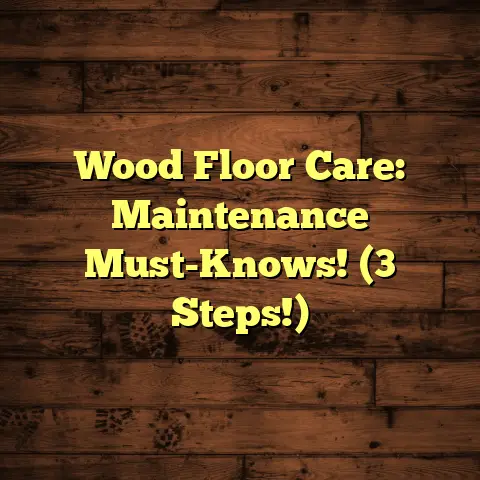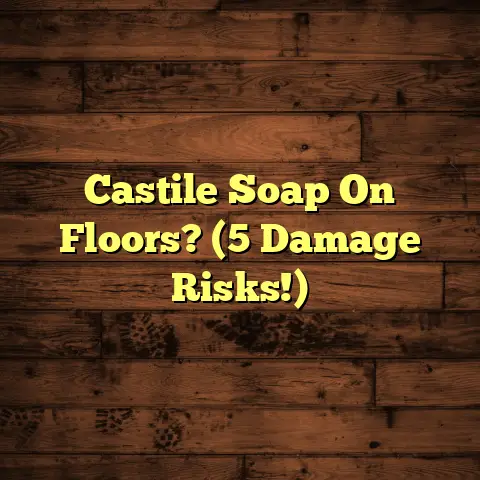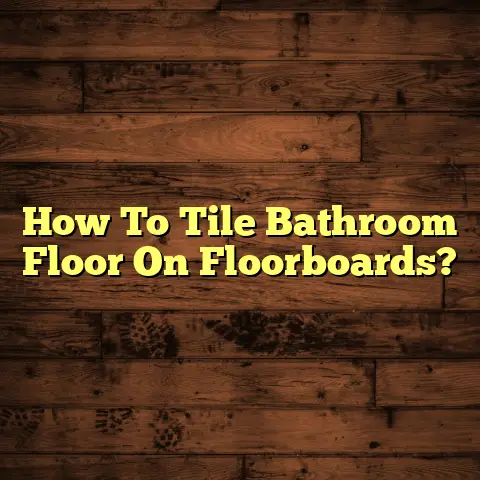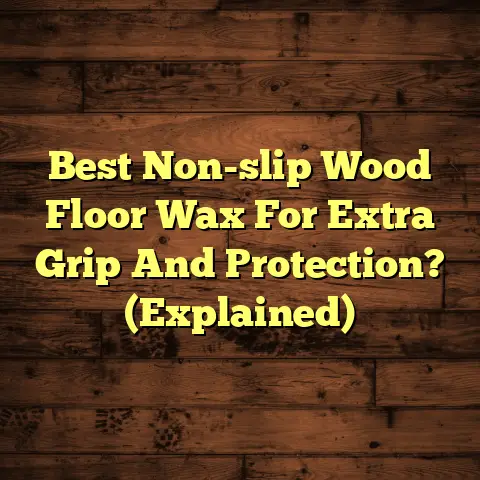Fix Wood Floor Scratches? (4 Pro Polish Hacks!)
And let’s be honest, your wood floors play a huge role in that.
They add warmth, character, and a touch of elegance to any room.
But here’s the thing: while beautiful and durable, hardwood can sometimes amplify sounds.
That’s why well-maintained wood floors are essential for creating a comfortable and tranquil living space.
Now, imagine this: you’ve got these gorgeous hardwood floors, but they’re marred by unsightly scratches.
Not only do these scratches detract from the overall beauty, but they can also contribute to noise.
How?
By disrupting the floor’s smooth surface, creating little bumps and ridges that can cause creaks and groans with every step.
Trust me, I’ve seen it happen countless times!
In this article, I’m going to share my top 4 pro polish hacks to fix those pesky wood floor scratches.
We’ll dive deep into understanding the different types of scratches, why quick repairs are essential, and how to use simple household items to restore your floors to their former glory.
Ready to get started?
Let’s get to it!
Section 1: Understanding Wood Floor Scratches
Okay, so what exactly is a scratch on a wood floor?
It’s more than just a cosmetic blemish.
It’s a sign that the protective layer of your floor has been compromised.
There are different types of scratches, and understanding them is the first step to fixing them:
Surface Scratches: These are the most common type.
They’re usually shallow and only affect the finish of the wood.
You’ll typically see them as light, hazy lines on the surface.Deeper Gouges: These penetrate deeper into the wood itself.
They’re more noticeable and can even leave a visible indentation.Finish Wear: This isn’t technically a scratch, but it’s related.
It’s when the finish has worn away over time, leaving the wood exposed and vulnerable to scratches and other damage.
What causes these scratches in the first place?
Well, life happens! Here are some of the usual suspects:
Pet Claws: Our furry friends can unintentionally wreak havoc on wood floors.
Their claws can easily scratch the surface, especially when they get excited and start running around.Furniture Movement: Dragging furniture across the floor is a recipe for disaster.
Even seemingly light furniture can leave scratches if it’s not properly protected.Foot Traffic: Everyday foot traffic, especially with shoes on, can contribute to scratches over time.
Dirt and grit get trapped under your shoes and act like sandpaper, slowly wearing away the finish.Kids playing: Let’s face it, kids can be hard on floors!
Toys, bikes, and other playtime activities can easily lead to scratches and dents.
Now, let’s talk about the impact of these scratches.
It’s not just about aesthetics, although that’s definitely a factor.
Scratches can also affect the functional aspects of your wood flooring.
Aesthetic Impact: Scratches make your floors look worn and tired.
They detract from the overall beauty of your home and can even make it look less clean.Functional Impact: Scratches can weaken the finish, making it more susceptible to moisture damage.
They can also create uneven surfaces that collect dirt and grime, making your floors harder to clean.Noise Levels: As I mentioned earlier, scratches can contribute to noise.
They disrupt the smooth surface of the floor, creating friction and causing creaks and groans when you walk across it.
I’ve seen floors that were once stunning become dull and noisy due to neglect.
Don’t let that happen to you!
Section 2: The Importance of Quick Repairs
So, you’ve got a few scratches on your wood floors.
Is it really that big of a deal?
Absolutely!
Addressing scratches promptly is crucial for maintaining the integrity of your floors and preventing further damage.
Think of it like a small crack in your windshield.
If you don’t fix it right away, it’ll eventually spread and become a much bigger problem.
The same principle applies to wood floor scratches.
Here’s why quick repairs are so important:
Preventing Further Damage: Scratches weaken the finish, making it more vulnerable to moisture.
If water seeps into the wood through a scratch, it can cause warping, swelling, and even rot.Maintaining the Finish: The finish on your wood floors is designed to protect the wood from wear and tear.
When the finish is scratched, it loses its protective properties.
Repairing scratches helps to restore the finish and prolong the life of your floors.Preventing Splintering: Deeper scratches can sometimes lead to splintering, which can be painful and dangerous.
Repairing scratches helps to smooth out the surface of the floor and prevent splinters.Maintaining Aesthetics: Let’s be honest, scratches just don’t look good.
Repairing them helps to keep your floors looking their best and maintain the overall beauty of your home.Increased Property Value: Well-maintained wood floors add value to your home.
If you’re planning to sell your house in the future, taking care of your floors can make a big difference in the selling price.
I remember one client who ignored a small scratch on their floor for months.
Eventually, water seeped in and caused significant damage, requiring a costly repair.
Had they addressed the scratch promptly, they could have saved themselves a lot of money and hassle.
Here are some of the long-term benefits of keeping your wood floors scratch-free:
-
Increased Lifespan: By protecting the finish and preventing moisture damage, you can significantly extend the lifespan of your wood floors.
-
Reduced Maintenance Costs: By addressing scratches promptly, you can avoid more costly repairs down the road.
Improved Air Quality: Scratches can trap dirt and allergens, which can negatively impact your indoor air quality.
Repairing scratches helps to keep your floors clean and improve the air you breathe.-
More Inviting Atmosphere: Let’s face it, a home with well-maintained wood floors just feels more inviting and comfortable.
Don’t wait until a small scratch becomes a big problem.
Take action now to protect your investment and keep your wood floors looking their best.
Section 3: Pro Polish Hack #1 – The Vinegar and Olive Oil Mixture
Alright, let’s get to the good stuff!
My first pro polish hack involves a simple yet effective mixture of vinegar and olive oil.
Yes, you read that right!
These common household ingredients can work wonders on light scratches.
Here’s a step-by-step guide on how to create and apply this mixture:
Ingredients:
- 1/2 cup white vinegar
- 1/2 cup olive oil
- Soft cloth (microfiber is best)
Instructions:
Clean the area: Before you start, make sure the area around the scratch is clean and free of dirt and debris.
You can use a damp cloth to wipe it down.-
Mix the ingredients: In a small bowl, combine the vinegar and olive oil.
Apply the mixture: Dip the soft cloth into the mixture and gently rub it onto the scratched area.
Make sure to follow the grain of the wood.-
Buff the surface: Use a clean, dry cloth to buff the surface until it shines.
-
Repeat if necessary: If the scratch is still visible, repeat the process.
The Science Behind It:
You might be wondering, “Why does this work?” Well, here’s a little science lesson:
Vinegar: Vinegar is a mild acid that helps to clean and dissolve dirt and grime.
It also helps to remove any residue from previous cleaning products.Olive Oil: Olive oil is a natural moisturizer that helps to nourish the wood and restore its shine.
It also helps to fill in small scratches and make them less noticeable.
Together, these two ingredients create a powerful cleaning and polishing solution that can effectively mask light scratches.
Tips for Effective Application:
-
Use a soft cloth: Avoid using abrasive cloths or scrub brushes, as they can damage the finish.
Follow the grain: Always rub the mixture in the direction of the wood grain.
This will help to blend the mixture into the surrounding wood.Don’t over-apply: Use just enough mixture to cover the scratched area.
Too much mixture can leave a sticky residue.-
Buff thoroughly: Buffing the surface is essential for achieving a smooth, even finish.
I’ve used this hack countless times on my clients’ floors, and it’s always a crowd-pleaser.
It’s a simple, affordable, and effective way to refresh your wood floors and mask those annoying light scratches.
Section 4: Pro Polish Hack #2 – The Baking Soda Paste
Okay, so the vinegar and olive oil mixture is great for light scratches, but what about those deeper ones?
That’s where my second pro polish hack comes in: baking soda paste!
Baking soda is a mild abrasive that can help to gently polish the wood and fill in scratches.
Here’s how to make and apply it:
Ingredients:
- 2 tablespoons baking soda
- 1 tablespoon water
- Soft cloth
- Toothpick (optional)
Instructions:
-
Make the paste: In a small bowl, mix the baking soda and water until you form a thick paste.
Apply the paste: Using a soft cloth or your fingertip, gently rub the paste into the scratch.
If the scratch is deep, you can use a toothpick to carefully apply the paste into the crevice.Let it dry: Allow the paste to dry completely.
This usually takes about 30 minutes.-
Buff the surface: Use a clean, dry cloth to buff the surface until it shines.
-
Repeat if necessary: If the scratch is still visible, repeat the process.
The Science Behind It:
Baking soda is a mild abrasive, meaning it has tiny particles that can gently scrub away dirt and grime.
When you rub the baking soda paste into the scratch, the abrasive particles help to smooth out the edges and fill in the gap.
Detailed Application Process:
-
Be gentle: Don’t scrub too hard, as this can damage the finish.
-
Use a circular motion: When applying the paste, use a gentle circular motion to help work it into the scratch.
-
Remove excess paste: After applying the paste, use a damp cloth to remove any excess.
-
Buff thoroughly: Buffing the surface is essential for achieving a smooth, even finish.
I’ve found that this hack works particularly well on scratches that are slightly deeper but haven’t penetrated the wood completely.
It’s a great way to minimize the appearance of scratches without having to resort to more drastic measures like sanding and refinishing.
Just remember to be patient and gentle, and you’ll be amazed at the results!
Section 5: Pro Polish Hack #3 – The Walnut Method
Now, for something a little different: the walnut method!
This is one of my favorite natural ways to fix scratches, and it’s surprisingly effective.
The idea behind this method is that the natural oils in walnuts can help to restore the color and shine of the wood, making scratches less noticeable.
Here’s how to do it:
Ingredients:
- Walnut (shelled)
- Soft cloth
Instructions:
-
Find a walnut: Choose a walnut that is slightly darker than the color of your wood floor.
Rub the walnut: Rub the walnut over the scratch, applying gentle pressure.
The oils from the walnut will start to transfer to the wood.-
Buff the surface: Use a soft cloth to buff the surface until it shines.
-
Repeat if necessary: If the scratch is still visible, repeat the process.
The Science Behind It:
Walnuts are rich in natural oils that can penetrate the wood and help to restore its color and shine.
The oils also help to fill in small scratches, making them less noticeable.
Insights on Why This Method Works:
-
Color Matching: The walnut’s natural pigment helps to blend the scratch with the surrounding wood.
-
Oil Penetration: The oils penetrate the wood, nourishing it and restoring its natural luster.
-
Easy Application: This method is incredibly easy to apply and requires no special tools or equipment.
I’ve found that this method works particularly well on lighter-colored woods, such as maple and birch.
It’s also a great option for floors with a natural oil finish.
One thing to keep in mind is that the walnut method may not work on all types of wood finishes.
It’s always a good idea to test it on a small, inconspicuous area first to make sure it doesn’t damage the finish.
Section 6: Pro Polish Hack #4 – Commercial Scratch Repair Products
Alright, let’s talk about the big guns: commercial scratch repair products.
These products are specifically designed to fix scratches on wood floors, and they can be very effective.
There are several types of commercial scratch repair products available, including:
Markers: These are like felt-tip pens filled with stain.
They’re great for small, superficial scratches.Fill Sticks: These are wax-based sticks that you rub into the scratch to fill it in.
They’re good for deeper scratches and gouges.-
Polishes: These are liquid polishes that you apply to the entire floor to restore its shine and mask scratches.
Comparison of Different Types of Products:
Key Ingredients to Look For:
- Urethane: Provides a durable, protective finish.
- Acrylic: Offers good clarity and scratch resistance.
- Wax: Adds shine and helps to fill in small scratches.
Step-by-Step Guide on How to Apply a Commercial Product:
- Clean the area: Make sure the area around the scratch is clean and free of dirt and debris.
- Choose the right product: Select a product that matches the color of your wood floor.
- Apply the product: Follow the instructions on the product label.
- Allow to dry: Allow the product to dry completely.
- Buff the surface: Use a soft cloth to buff the surface until it shines.
Preparation and Finishing Steps for Optimal Results:
- Test in an Inconspicuous Area: Before applying the product to the entire scratch, test it in a small, hidden area to make sure it matches the color and doesn’t damage the finish.
- Apply Thin Coats: Apply the product in thin, even coats to avoid a buildup of residue.
- Allow Sufficient Drying Time: Allow the product to dry completely before buffing the surface.
I’ve used countless commercial scratch repair products over the years, and I’ve found that some are definitely better than others.
Do your research, read reviews, and choose a product that is specifically designed for your type of wood floor and finish.
Section 7: Preventative Measures for Wood Floor Maintenance
Okay, so we’ve talked about how to fix scratches, but what about preventing them in the first place?
Prevention is always better than cure, right?
Here are some preventative measures you can take to protect your wood floors from future scratches:
Use Area Rugs: Place area rugs in high-traffic areas, such as hallways and entryways.
This will help to protect the floors from wear and tear.Use Furniture Pads: Attach felt pads to the legs of all your furniture.
This will prevent scratches when you move the furniture around.Regular Maintenance Routines: Sweep or vacuum your floors regularly to remove dirt and debris.
This will prevent dirt from scratching the finish.Avoid Wearing Shoes Indoors: Encourage family members and guests to remove their shoes before entering the house.
This will help to reduce the amount of dirt and grit that gets tracked onto the floors.-
Trim Pet’s Nails: Keep your pet’s nails trimmed to prevent them from scratching the floors.
Techniques for Reducing Noise:
-
Felt Pads Under Furniture Legs: As mentioned earlier, felt pads not only prevent scratches but also reduce noise by cushioning the furniture legs.
Keep Floors Clean: Dirt and grit can cause scratches and also contribute to noise.
Regular cleaning helps to keep your floors smooth and quiet.-
Consider Underlayment: If you’re installing new wood floors, consider using a sound-dampening underlayment to reduce noise transmission.
I always tell my clients that proper maintenance is the key to keeping their wood floors looking beautiful for years to come.
A little bit of prevention can go a long way in avoiding costly repairs down the road.
Conclusion
So, there you have it: my top 4 pro polish hacks for fixing wood floor scratches!
We’ve covered everything from understanding the different types of scratches to using simple household ingredients to restore your floors to their former glory.
Remember, addressing wood floor scratches is not just about aesthetics.
It’s also about maintaining the integrity of your floors, preventing further damage, and creating a peaceful and inviting home environment.
By using these pro polish hacks and taking preventative measures, you can keep your wood floors looking their best for years to come.
I encourage you to take action on your wood flooring issues today.
Don’t let those scratches detract from the beauty and functionality of your living spaces.
With a little bit of effort, you can restore your floors to their pristine condition and enjoy the warmth and elegance of wood flooring for many years to come.
Now go ahead and give these hacks a try.
I’m confident that you’ll be amazed at the results!
And if you have any questions or need further assistance, don’t hesitate to reach out to a professional flooring contractor.
We’re always here to help!
